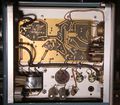111: Difference between revisions
No edit summary |
No edit summary |
||
| Line 13: | Line 13: | ||
File:Tek_111_left.jpg|Left Internal View | File:Tek_111_left.jpg|Left Internal View | ||
File:Tek 111 right.jpg|Right Internal View | File:Tek 111 right.jpg|Right Internal View | ||
File:Tek_111_rear.jpg| | File:Tek_111_rear.jpg|Late serial number rear view | ||
Tek 111 rear2.jpg | Tek 111 rear2.jpg|Early serial number rear view | ||
Image:Tek 111 schem.gif|Schematic | Image:Tek 111 schem.gif|Schematic | ||
</gallery> | </gallery> | ||
Revision as of 16:12, 3 May 2017
The Tektronix Type 111 Pretrigger Pulse Generator produces two pulse signals: one to trigger an oscilloscope sweep and a main output pulse to stimulate the device under test. The trigger pulse comes between 30 and 250 nanoseconds before the output pulse; this is controlled by a knob on the 111. This gives adequate time for the oscilloscope to start sweeping so that the leading edge of the input or output signals of the device under test can be viewed. The alternative is to have a delay line in the signal path, after the trigger pickoff, but delay lines degrade transient performance. Using a pretrigger eliminates the need for a delay line in the vertical signal path and therefore enables accurate high-speed measurements.
The main output pulse of the Type 111 is produced by an avalanche transistor. The risetime is specified as "0.3 nanosecond" in the Auxiliary Equipment section at the end of the Type N manual, and "equal to or less than 500 picoseconds" in the Characteristics section of the 111 manual.
For a stable display, it is essential for the delay between pretrigger and main pulse to be stable, free of jitter. The pretrigger-to-main pulse jitter of the Type 111 is specified as 100ps. The repetition rate is 10/sec to 100,000/sec. The main output pulse amplitude is specified to be at least 10 volts into 50 ohms.
-
Front View
-
Left Internal View
-
Right Internal View
-
Late serial number rear view
-
Early serial number rear view
-
Schematic





